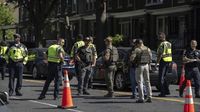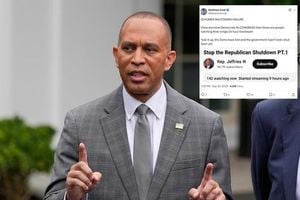In a series of alarming incidents that have gripped the nation’s capital and beyond, law enforcement agencies have moved swiftly to address threats against political figures and a surge in violent crime. At the heart of these developments lies a chilling episode in Austin, Texas, and a sweeping federal crime crackdown in Washington, D.C., both unfolding in late August 2025.
On August 25, 2025, Thomas Austria Crouse, a resident of Austin, Texas, allegedly launched into a spree of menacing voicemails targeting a staff member of President Donald Trump. According to the U.S. Attorney’s Office for the Western District of Texas, Crouse’s messages were not only explicit in their violence but also deeply personal. He is accused of threatening to decapitate the unnamed staffer and, in a further escalation, to “slaughter their entire family.”
The specificity of the threats—directly referencing the staffer’s employment with President Trump—set off immediate alarm bells. The FBI wasted no time, initiating an investigation that would quickly involve the U.S. Secret Service and Capitol Police as well. Within less than a day, authorities had traced the calls back to Crouse, demonstrating the seriousness with which such threats are handled in the post-2020 political landscape.
Federal agents confronted Crouse on August 26, 2025. During this interview, as reported by the U.S. Attorney’s Office, Crouse agreed to cease his campaign of intimidation. Yet, in a disturbing turn of events, he allegedly disregarded this commitment mere hours later, leaving five additional voicemails for the Trump staffer. This time, the messages urged the staffer to take their own life—a chilling escalation that only deepened the sense of urgency among investigators.
By August 27, 2025, Crouse was under arrest, bringing a swift end to the three-day ordeal. The criminal complaint filed against him includes charges of transmitting an interstate communication containing a threat to injure another person. If convicted, Crouse could face up to five years in prison. According to the Associated Press, the FBI, U.S. Secret Service, and Capitol Police continue to investigate the case, underscoring the gravity with which threats against public officials and their staff are now treated.
The White House has yet to issue a public statement on the incident. However, as The New York Post and other outlets have noted, threats against Trump’s staff—and the former president himself—have become an all-too-common occurrence since his landslide victory in November 2024. In the weeks following the election, multiple cabinet nominees and administration appointees were subjected to bomb threats at their homes. More recently, in early August 2025, a Pennsylvania man was arrested for threatening to kill President Trump, lamenting what he described as the nation’s slide toward a “literal oligarchy.”
These incidents are not isolated. According to 7News and official statements from Attorney General Pam Bondi, the federal government has intensified its efforts to combat crime in Washington, D.C., through a broad law enforcement operation. As of September 1, 2025, a staggering 1,528 arrests have been made under President Trump’s federal initiative to tackle crime in the nation’s capital. The operation has gained momentum, with 76 arrests occurring on Saturday, August 30 alone.
Among those detained were two individuals accused of making threats against law enforcement—a stark reminder of the dangers faced by those tasked with upholding public safety. In a particularly high-profile case, a suspect was arrested for allegedly threatening to kill President Trump and assaulting a federal officer. The operation also netted an illegal immigrant accused of being a member of the notorious MS-13 gang, a detail that has reignited debates over immigration enforcement and public safety.
Law enforcement’s efforts have not been limited to arrests. Bondi reported that 151 illegal firearms have been seized since the onset of the federal operation, a figure that highlights the ongoing challenge of gun violence in urban areas. The crackdown has drawn both praise and criticism, reflecting the nation’s deep divisions over law enforcement tactics, civil liberties, and the root causes of crime.
For supporters of the federal operation, these numbers serve as evidence of decisive leadership and a commitment to restoring order. They argue that the arrest of gang members, the removal of illegal guns from the streets, and the swift response to threats against public officials are necessary measures in an era of heightened political tension and rising urban crime rates. In their view, the administration’s approach is a much-needed corrective to what they see as years of insufficient action.
Critics, however, raise concerns about the broader implications of such crackdowns. Some worry that aggressive law enforcement tactics risk violating civil liberties or disproportionately targeting marginalized communities. Others question whether a focus on high-profile arrests and headline-grabbing operations addresses the underlying social and economic conditions that contribute to crime. As 7News noted, even within the Democratic Party, there is ongoing debate about the best way to tackle crime, with some arguing that the current approach may not yield long-term solutions.
Amid these debates, the safety of public officials and their staff remains a pressing concern. The threats faced by Trump’s team are part of a broader trend that has seen political figures across the spectrum targeted with increasing frequency. The involvement of multiple federal agencies—the FBI, Secret Service, and Capitol Police—in the Crouse case reflects a new reality in which political violence and intimidation are treated as urgent national security threats.
As the investigations in both Austin and Washington continue, questions linger about how best to balance public safety, civil liberties, and the open discourse that is central to American democracy. The rapid arrest of Thomas Austria Crouse and the hundreds of detentions in D.C. demonstrate the federal government’s capacity for swift action. Whether these measures will achieve lasting results—or simply mark another chapter in the nation’s ongoing struggle with violence and division—remains to be seen.
For now, the message from law enforcement is clear: threats against public officials, their families, and law enforcement personnel will be met with the full force of federal authority. As the nation grapples with the consequences of these turbulent times, the events of late August 2025 serve as a stark reminder of the challenges facing American democracy and the high stakes involved in protecting those who serve it.




